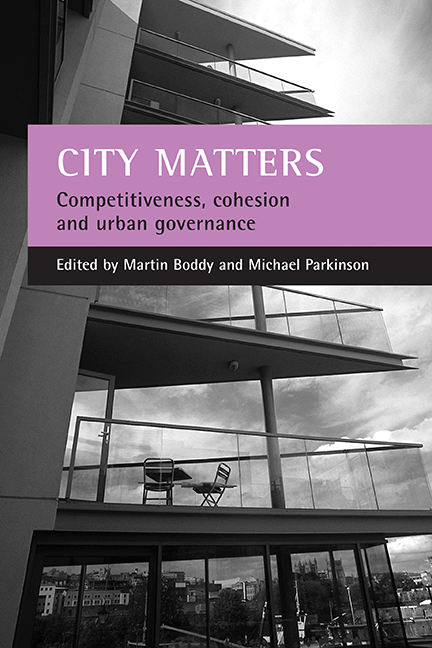Book contents
- Frontmatter
- Contents
- List of tables and figures
- Foreword
- Acknowledgements
- Notes on contributors
- one Introduction
- Part One Competitiveness, cohesion and urban governance
- Part Two Competitiveness and urban change
- Part Three Competitiveness, innovation and the knowledge economy
- Part Four Housing, property and economic performance
- Part Five Space, place and social cohesion
- Part Six Ethnicity, enterprise and social cohesion
- Part Seven Leadership, governance and social capital
- Conclusions
- Index
ten - Innovation clusters and competitive cities in the UK and Europe
Published online by Cambridge University Press: 20 January 2022
- Frontmatter
- Contents
- List of tables and figures
- Foreword
- Acknowledgements
- Notes on contributors
- one Introduction
- Part One Competitiveness, cohesion and urban governance
- Part Two Competitiveness and urban change
- Part Three Competitiveness, innovation and the knowledge economy
- Part Four Housing, property and economic performance
- Part Five Space, place and social cohesion
- Part Six Ethnicity, enterprise and social cohesion
- Part Seven Leadership, governance and social capital
- Conclusions
- Index
Summary
Introduction
International competition, particularly from low-wage, newly industrialising countries (NICs), is forcing many changes on the advanced economies in terms of business strategy. It is becoming increasingly difficult for the latter to compete in international markets, particularly in manufacturing, on the basis of price alone. For them, competitive advantage is to be found more in the quality of their goods and services. Much of this quality is based on sophisticated scientific, technical and managerial knowledge. The transfer of this knowledge into commercial products and services via the crucial process of innovation is therefore becoming one of the main ways for ‘first world’ economies to develop their competitive capabilities in international markets.
Innovation is so important because:
At the level of the economy, innovation is the single most important engine of long-term competitiveness, growth and employment. The OECD estimates that between 1970 and 1995 more than half of the total growth in output of the developed world resulted from innovation, and the proportion is increasing as the economy becomes more knowledge-intensive. (Innovation and Technology Transfer, 2000)
While there is widespread agreement that innovation drives economic growth, there is very little analysis of why this is the case. Thus, one of the key questions of this research was: ‘How does innovation lead to growth?’
For the purposes of this research, innovation was defined as:
the commercially successful exploitation of new technologies, ideas or methods through the introduction of new products or processes, or through the improvement of existing ones. Innovation is a result of an interactive learning process that involves often several actors from inside and outside the companies. (EC, 1996, p 54)
The growing importance of innovation is recognised by the fact that it is now monitored on a European-wide basis by the Community Innovation Survey that is conducted every four years. EUROSTAT also compiles the European Trend Chart on Innovation that aims to build a comprehensive picture of innovation and innovation policies across Europe. A picture is emerging from this data of the strengths and weaknesses of different urban regions across Europe with respect to innovation. Low innovation rates are one of the three major weaknesses to be found in a number of European regions.
- Type
- Chapter
- Information
- City MattersCompetitiveness, Cohesion and Urban Governance, pp. 171 - 196Publisher: Bristol University PressPrint publication year: 2004

